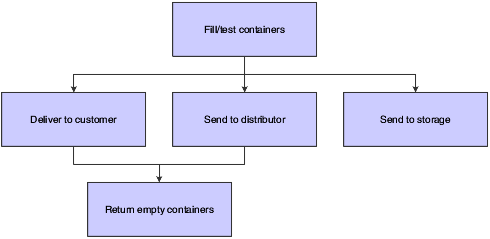Inventory and the Container Life Cycle
Companies usually carry an extremely large inventory of containers, most of which are in constant circulation with customers. The sale of products in containers involves a unique inventory process. You loan containers to the customers to store the product that they purchase until the product is depleted. The customers then return the containers to you, usually in exchange for full containers. You maintain ownership of the containers while they are in the possession of the customer. These outgoing and incoming transactions, in which containers are not sold, present two main issues for the company:
The containers are valuable.
You retain responsibility for them while they are in the customer's possession. You must always be able to track and account for these containers.
The customer pays a deposit fee or rental fee for each container.
You must track these fees separately from the invoicing for the product.
You can use container management to manage the regular exchange of containers and the payment of deposit and rental fees and refunds.
This chart illustrates the container life cycle:

Normally, the supplying company purchases the container and introduces it into the cycle at the filling plant. After you fill and test the container, you either deliver it to the customer or send it to storage for future delivery. You can also send the full container to a distributor who, in turn, delivers it to the customer. The customer and distributor return the empty container to you after the product that it contains is depleted.
As the container repeats this cycle for a period of time, it eventually requires maintenance. Maintenance is critical for storing the product safely in the container. You must inspect the container after every cycle through the filling plant. After a number of cycles, you can no longer use the container because it is damaged beyond repair, and you must scrap it.
You use container management to track the container through the cycles and manage the deposits and refunds that must be generated for these exchanges.